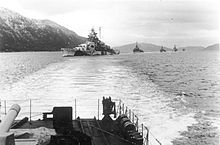German destroyer Z29
Z29 participated in the indecisive Battle of the Barents Sea at the end of the year, during which she helped to sink a British minesweeper.
British attacks on the German ships were generally ineffective until the battleship Scharnhorst struck a mine off the mouth of the Scheldt Estuary at 15:30.
Vizeadmiral (Vice Admiral) Otto Ciliax, overall commander of the German force, summoned Z29 to take him aboard from the immobilized battleship.
Later that day, a 15 cm shell exploded in one of the aft guns, killing one man, severing oil lines, and knocking out the port turbine.
[7] After they were completed, she was part of the screen for the heavy cruiser Lützow from 15 to 26 May as she moved from Germany to Bogen Bay, Norway and laid a minefield in the Skagerrak en route.
Later that month, she participated in Operation Zarin, a minelaying mission off the coast of Novaya Zemlya from 24 to 28 September, together with Admiral Hipper, and her sisters Z23, Z28, and Z30.
Vizeadmiral Oskar Kummetz's plan was to divide his force in half; he would take Admiral Hipper, Z4 Richard Beitzen, Z29 and the destroyer Z16 Friedrich Eckoldt north of the convoy to attack it and draw away the escorts.
The destroyer HMS Obdurate spotted them in turn and closed to investigate when the German ships opened fire at a range of 8,000 meters (8,700 yd).
This took some time in the poor visibility and Hipper was surprised in the meantime by the British covering force of the light cruisers Sheffield and Jamaica.
After sinking Bramble, the German destroyers attempted to rejoin Hipper but had no idea that British cruisers were in the area.
During Operation Zitronella, the German raid on the island of Spitsbergen in September, they were tasked with fire support for the troops ashore.
[7] The ship was one of the escorts for Scharnhorst during Operation Ostfront on 25 December, an attempt to intercept the British Convoy JW 55B that was bound for the Soviet Union.
All of the battleship's escorts were detached the following day to increase the likelihood of intercepting the convoy and did not participate in the ensuing Battle of North Cape.
On 17 July the ship was strafed by aircraft fighters of the Royal Navy's Fleet Air Arm during Operation Mascot, an attack on the battleship Tirpitz, but only suffered superficial damage.
[14] A week later, she sailed from Laafjord for Wesermünde to begin a refit that replaced her forward gun with the twin-gun turret and greatly augmented her anti-aircraft armament.

